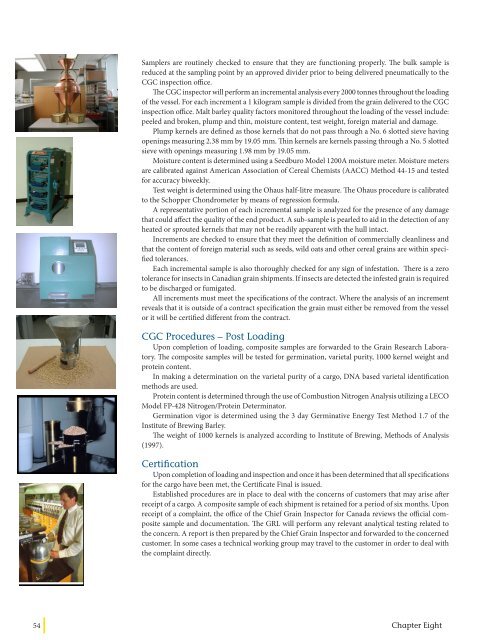MALTING QUALITY TRAITS - Canadian Malting Barley Technical ...
MALTING QUALITY TRAITS - Canadian Malting Barley Technical ...
MALTING QUALITY TRAITS - Canadian Malting Barley Technical ...
You also want an ePaper? Increase the reach of your titles
YUMPU automatically turns print PDFs into web optimized ePapers that Google loves.
Samplers are routinely checked to ensure that they are functioning properly. The bulk sample is<br />
reduced at the sampling point by an approved divider prior to being delivered pneumatically to the<br />
CGC inspection office.<br />
The CGC inspector will perform an incremental analysis every 2000 tonnes throughout the loading<br />
of the vessel. For each increment a 1 kilogram sample is divided from the grain delivered to the CGC<br />
inspection office. Malt barley quality factors monitored throughout the loading of the vessel include:<br />
peeled and broken, plump and thin, moisture content, test weight, foreign material and damage.<br />
Plump kernels are defined as those kernels that do not pass through a No. 6 slotted sieve having<br />
openings measuring 2.38 mm by 19.05 mm. Thin kernels are kernels passing through a No. 5 slotted<br />
sieve with openings measuring 1.98 mm by 19.05 mm.<br />
Moisture content is determined using a Seedburo Model 1200A moisture meter. Moisture meters<br />
are calibrated against American Association of Cereal Chemists (AACC) Method 44-15 and tested<br />
for accuracy biweekly.<br />
Test weight is determined using the Ohaus half-litre measure. The Ohaus procedure is calibrated<br />
to the Schopper Chondrometer by means of regression formula.<br />
A representative portion of each incremental sample is analyzed for the presence of any damage<br />
that could affect the quality of the end product. A sub-sample is pearled to aid in the detection of any<br />
heated or sprouted kernels that may not be readily apparent with the hull intact.<br />
Increments are checked to ensure that they meet the definition of commercially cleanliness and<br />
that the content of foreign material such as seeds, wild oats and other cereal grains are within specified<br />
tolerances.<br />
Each incremental sample is also thoroughly checked for any sign of infestation. There is a zero<br />
tolerance for insects in <strong>Canadian</strong> grain shipments. If insects are detected the infested grain is required<br />
to be discharged or fumigated.<br />
All increments must meet the specifications of the contract. Where the analysis of an increment<br />
reveals that it is outside of a contract specification the grain must either be removed from the vessel<br />
or it will be certified different from the contract.<br />
CGC Procedures – Post Loading<br />
Upon completion of loading, composite samples are forwarded to the Grain Research Laboratory.<br />
The composite samples will be tested for germination, varietal purity, 1000 kernel weight and<br />
protein content.<br />
In making a determination on the varietal purity of a cargo, DNA based varietal identification<br />
methods are used.<br />
Protein content is determined through the use of Combustion Nitrogen Analysis utilizing a LECO<br />
Model FP-428 Nitrogen/Protein Determinator.<br />
Germination vigor is determined using the 3 day Germinative Energy Test Method 1.7 of the<br />
Institute of Brewing <strong>Barley</strong>.<br />
The weight of 1000 kernels is analyzed according to Institute of Brewing, Methods of Analysis<br />
(1997).<br />
Certification<br />
Upon completion of loading and inspection and once it has been determined that all specifications<br />
for the cargo have been met, the Certificate Final is issued.<br />
Established procedures are in place to deal with the concerns of customers that may arise after<br />
receipt of a cargo. A composite sample of each shipment is retained for a period of six months. Upon<br />
receipt of a complaint, the office of the Chief Grain Inspector for Canada reviews the official composite<br />
sample and documentation. The GRL will perform any relevant analytical testing related to<br />
the concern. A report is then prepared by the Chief Grain Inspector and forwarded to the concerned<br />
customer. In some cases a technical working group may travel to the customer in order to deal with<br />
the complaint directly.<br />
54 Chapter Eight


